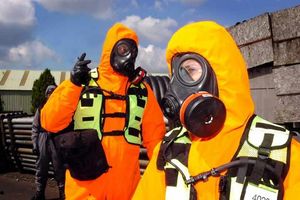Chemical disaster training for 999 services
Emergency services were scrambled to deal with a potentially life-threatening chemical disaster involving 50 Eastern European workers in Telford. [caption id="attachment_68472" align="aligncenter" width="450" caption="Police wear protective clothing during the exercise"][/caption] Emergency services were scrambled to deal with a potentially life-threatening chemical disaster involving 50 Eastern European workers in Telford. The alert was sparked after one of the workers dropped a box containing a mystery substance and people reported breathing difficulties and burning sensations in their noses – but it was all part of a training exercise. For pictures click here For video click here Read the full story in today's Shropshire Star

Emergency services were scrambled to deal with a potentially life-threatening chemical disaster involving 50 Eastern European workers in Telford.
The alert was sparked after one of the workers dropped a box containing a mystery substance and people reported breathing difficulties and burning sensations in their noses – but it was all part of a training exercise.
Firefighters and police set up a 100m exclusion zone and West Ambulance Service's Hazard Area Response Team was called in as part of a major chemical, biological, radioactive and nuclear training exercise, organised by Shropshire Fire and Rescue Service at MoD Donnington, to prepare the county for a major catastrophe.
The four-hour long Exercise Brave Heart involved volunteer students from Telford College of Arts and Technology playing the part of the stricken workers and began with an emergency call to Shropshire Fire and Rescue Service's Shrewsbury headquarters.
Emergency workers including 50 firefighters, 30 police officers, MoD firefighters, Environment Agency specialists, council officers and ambulance staff then swung into action. Workers, including walking wounded and others in distress, were led to disrobing units before entering a 30ft long decontamination unit.
Fire officers in protective suits took a sample of the unknown substance which was tested and run through a database of 5,000 chemicals to identify it.
Neil Griffiths, from Shropshire Fire and Rescue Service, said: "This was our sixth training event and it was a useful multi-agency exercise in which we work together to co-ordinate our approach to a potentially dangerous and life threatening incident."





